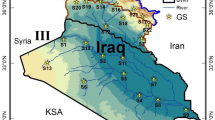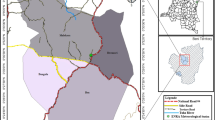Abstract
In this study, drought characteristics of three stations namely Tabriz, Bandar-e Anzali and Zahedan are analyzed from 1951 to 2012 using the effective drought index (EDI). For this purpose daily precipitation records of each station are arranged in a distinct column of excel spreadsheet. Long-term daily average of the day (in daily scale) is substituted for missing data. In this study, effective precipitation index (EPI) is calculated, too. This is accomplished once for dummy duration (365 days) and once again for actual duration. Then daily mean effective precipitation (MEP) for each day of a year is calculated. Moreover, differences between effective precipitation (EP) and MEP are calculated and named DEP. Then standardized values of DEP (shown with SEP) are calculated, too. Precipitation needed for returning to normal condition (shown with PRN) is calculated for every station. At last, the EDI for each station in whole time period is obtained. In this study, time series including: (1) daily EPI (for dummy period of 365 days as well as actual duration), (2) MEP, (3) DEP, (4) SEP, (5) PRN and (6) EDI for every station are plotted. Results showed that years 2007–2008, 2007–2008 and 2001–2002 were known as the driest years in the 60 years time period, respectively, for Tabriz, Bandar-e Anzali and Zahedan stations. Based on the number of dry days occurred for each station it can be calculated that Bandar-e Anzali, Tabriz and Zahedan having the 2407, 1517 and 1338 dry days in the whole time period ranked in the first to third orders.




Similar content being viewed by others
References
Akhtari R, Mahdian M, Morid S (2006) Spatial analysis of drought indices including SPI and EDI in Tehran. Iran Water Res Res 2(3):27–38
Byun H, Kim D (2010) Comparing the effective drought index and standardized precipitation drought index. Options Mediterr Series A 95:85–89
Byun H, Wilhite D (1999) Objective quantification of drought severity and duration. J Clim 12:2747–2756
Hoseiny B (2013) Analysis of characteristics of drought using RDI drought index in northwestern of Iran. M.S. Thesis. Faculty of Agriculture. University of Tabriz
Jain V, Pandey R, Jain M, Byun H (2015) Comparison of drought indices for appraisal of drought characteristics in the Ken River Basin. Weather Clim Extremes 8:1–11
Kim D, Byun H, Choi K (2009) Evaluation, modification, and application of the effective drought index to 200-year drought climatology of Seoul, Korea. J Hydrol 378:1–12
Mogadassi M, Morid S, Gaemi H, Mohammad Vali Samani J (2005a) Daily drought monitoring in Tehran. J Iran Agric Sci 36(1):51–62
Mogadassi M, Paymozd Sh, Morid S (2005b) Spatial analysis of Tehran’s drought occurred in 1998–99 to 2000–01 by DI, SPI, EDI indices and GIS. J Hum 9(1):197–215
Morid S, Paymozd SH (2007) Comparison of hydrological and meteorological methods for daily drought monitoring (case study: Tehran’s drought occurred in 1999–2001). Agric Nat Res Sci 11(42):325–333
Morid S, Smakhtin V, Bagerzadeh K (2007) Drought forecasting using artificial neural networks and time series of drought Indices. Int J Climatol 27:2103–2111
Padhee S, Nikam B, Aggarwal S, Garg V (2014) Integrating effective drought index (EDI) and remote sensing derived parameters for agricultural drought assessment and prediction in Bandelkhand region of India. Int Arch Photo Grammetry Remote Sens Spatial Inf Sci 8:89–100
Wambua R, Mutua B, Rauda J (2014) Performance of standardized precipitation index (SPI) and effective drought index (EDI) in drought forecasting using artificial neural networks (ANNs) for upper Tana River basin, Kenya. Int J Eng Res Technol 3(11):547–556
Acknowledgement
In this study, the helpful comments of Dr. Mogadassi improved the quality of study, which is hereby heartily acknowledged.
Author information
Authors and Affiliations
Corresponding author
Additional information
Publisher's Note
Springer Nature remains neutral with regard to jurisdictional claims in published maps and institutional affiliations.
Rights and permissions
About this article
Cite this article
Ekhtiari, S., Dinpashoh, Y. Application of effective drought index (EDI) in characterizing drought periods (case study: Tabriz, Bandar-e Anzali and Zahedan stations). Sustain. Water Resour. Manag. 5, 1723–1729 (2019). https://doi.org/10.1007/s40899-019-00315-4
Received:
Accepted:
Published:
Issue Date:
DOI: https://doi.org/10.1007/s40899-019-00315-4




